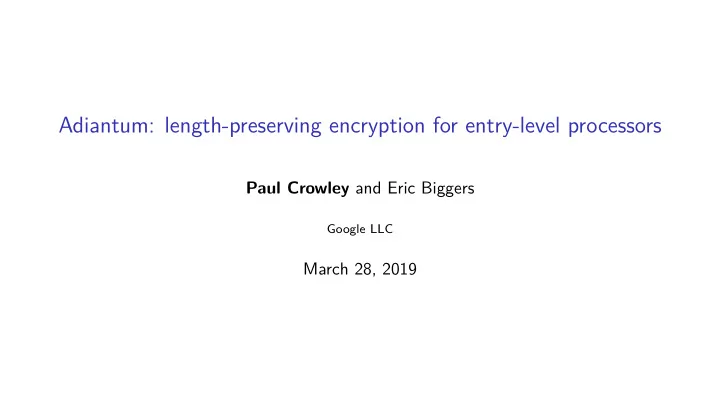

Adiantum: length-preserving encryption for entry-level processors Paul Crowley and Eric Biggers Google LLC March 28, 2019
Overview • The problem • The solution
Section 1 The problem
The problem • Hardware (eg ARM CE) makes AES fast • …but some devices don’t have it
The solution (for TLS) • RFC7539 • ChaCha for encryption • Poly1305 for authentication • Much faster
But… • RFC7539 is an AEAD mode, so | C | > | P | • nonce • MAC • Storage encryption requires | C | = | P |
Full disk encryption • 4KiB virtual sector <-> 4KiB real sector • No special fmash hardware
File based encryption • Databases update sectors • If read/write of one sector touches two sectors… • Atomicity more diffjcult • Speed is halved • Lifetime is halved
Android Android “Compatibility Defjnition Document”, version 8.1, section 9.9: If device implementations […] support data storage encryption with Advanced Encryption Standard (AES) crypto performance above 50MiB/sec, they MUST enable the data storage encryption by default […]
Section 2 The solution
Formal properties • Deterministic • No nonce • Tweakable super-pseudorandom permutation (SPRP) • family of permutations indexed by tweak and length • indistinguishable from random permutations • attacker can query f , f − 1
AES-XTS • 128-bit tweakable SPRP • 4KiB sector: applied 256 times • Two-part tweak • Cortex A7: 58.6 cpb (decryption)
Whole sector encryption • 4KiB tweakable SPRP • every bit of plaintext afgects all of ciphertext • every bit of ciphertext afgects all of plaintext • every tweak a new permutation • opportunity to be faster
Three-pass structure • SPRP: read all before writing any • same in decryption direction • minimum three passes • hash-XOR-hash faster than XOR-hash-XOR
HCTR, HCH • hash-XOR-hash structure • Block cipher defeats LR attack • But no faster on our hardware (AES, GF ( 2 128 ) )
HPolyC and Adiantum P 128 bits Hash ChaCha T AES Hash 128 bits C with block cipher cpb • Similar structure: hash-XOR-hash • More parallel decryption • Use RFC7539 primitives • HPolyC-ChaCha20-AES: 17.8 cpb • Use ChaCha12 instead: HPolyC, 13.6 • Use NH • …but combine with Poly1305 • Adiantum: 10.6 cpb
Performance 15.8 58.6 AES-256-XTS (decryption) 43.9 42.7 AES-128-XTS (decryption) 27.9 26.9 NOEKEON-XTS 23.4 17.8 HPolyC-XChaCha20-AES 16.9 Speck128/256-XTS Table: Performance on ARM Cortex-A7 20.2 14.7 Adiantum-XChaCha20-AES 18.7 13.6 HPolyC-XChaCha12-AES 15.8 10.6 Adiantum-XChaCha12-AES cpb (512) cbp (4096) Algorithm 60.1
Proof (main step) hash key Hash f T Hash P C world Y length and tweak • Adversary distinguishes world X and • Plaintext, ciphertext queries, any π • World X: Adiantum, with random permutation π and random function f • World Y: all answers random • H-coeffjcient technique • After fjnal query, attacker gets the
Bad transcripts P Hash h P T h C Hash C P Hash h P T h C Hash C
Bad transcripts P Hash h C T h P Hash 2 C • Results are random in world Y • Collision in result: 2 − 128 • We forbid pointless queries • Collision in query: at most ǫ • Total across all queries: at most ( ǫ + 2 − 128 ) � q �
Good transcripts before this one Hash f T Hash P 1 C 1 • In world Y, all responses have probability 2 −| P | • In world X • probability f has right output: 2 − ( | P |− 128 ) π • probability π has right output: 2 128 − i • where i is the number of queries • These are independent, so overall probability is 2 − ( | P |− 128 ) 2 128 − i • …which is equal to or slightly larger than 2 −| P |
H-coeffjcient technique distinguishing advantage Hash f T Hash P 2 C likely in world X as world Y 2 • Every good transcript is at least as π • Probability of bad transcript ≤ ( ǫ + 2 − 128 ) � q � • By H-coeffjcient technique, ≤ ( ǫ + 2 − 128 ) � q �
Security Distinguishing bound quadratic in queries, linear in message/tweak lenth 2 where � q � ( 3 ( 2 − 128 ) + 2 − 103 max( 1 + ⌈ l T / 128 ⌉ , 2 ⌈ ( l M − 128 ) / 8192 ⌉ )) S KS ( 1 + q , 9088 + q ( l M − 128 ) , t ′ ) + Adv ± prp E KE ( q , t ′ ) + Adv sc • q : number of queries • l T , l M : maximum length of tweak, message in bits • Adv ± prp E KE ( q , t ′ ) : distinguishing advantage against AES-256 S KS ( q , l , t ′ ) : distinguishing advantage against XChaCha12 • Adv sc • t ′ = t + O ( q ( l T + l M ))
Adiantum in Android • Part of Linux 5.0 • Android “dessert” releases • Cupcake, Donut, Eclair, … • …, Oreo (2017), Pie (2018) , “Q” (2019) • Some Android Pie devices will use it • No carveout: devices shipping “Q” will all be encrypted
Recommend
More recommend